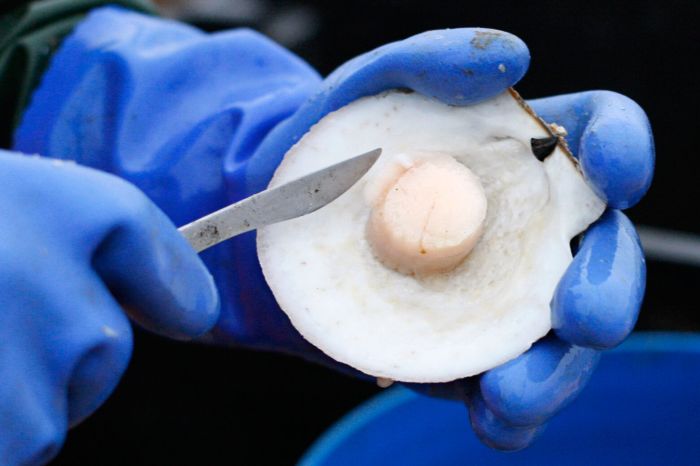Delve into the fascinating world of scallop fishing with our comprehensive guide, “How to Catch a Scallop.” Whether you’re a seasoned angler or just starting out, this guide will equip you with the knowledge and techniques to successfully harvest these delectable bivalves.
Scallops, with their delicate flavor and firm texture, are a prized catch for both recreational and commercial fishermen. Our guide covers everything you need to know, from understanding scallop biology and behavior to identifying their habitats and employing effective fishing techniques.
Fishing Techniques
Scallops can be caught using a variety of methods, including dredging, diving, and snorkeling.
Dredging
- Involves dragging a heavy metal frame with a mesh bag along the seafloor to collect scallops.
- Requires a large vessel and specialized equipment.
- Can be efficient for harvesting large quantities of scallops but can also damage the seafloor.
Diving, How to catch a scallop
- Involves using scuba gear or free-diving to locate and collect scallops by hand.
- Requires less equipment than dredging but is more labor-intensive.
- Selective and allows for the collection of high-quality scallops.
Snorkeling

- Similar to diving but using only a snorkel and mask.
- Limited to shallow waters and less effective than diving.
- Can be used for recreational purposes or small-scale harvesting.
Scallop Biology and Behavior
Scallops are bivalve mollusks with a distinctive fan-shaped shell.
Physical Characteristics
- Two hinged shells connected by a hinge ligament.
- Scalloped edges on the shell provide protection and increase swimming efficiency.
- Eyes and tentacles around the shell margin for sensory perception.
Life Cycle
- Begin as planktonic larvae that settle on the seafloor as juveniles.
- Attach to hard substrates using byssal threads.
- Mature into adults capable of swimming short distances by clapping their shells.
Feeding Habits
- Filter feeders that consume phytoplankton and other microscopic organisms.
- Create a feeding current by clapping their shells.
- Feed primarily at night and during periods of low tide.
Habitat and Distribution
Scallops are found in a wide range of habitats worldwide.
Habitat Preferences
- Sandy or muddy seabeds with moderate currents.
- Prefer depths ranging from shallow waters to over 100 meters.
- Require clean water with sufficient oxygen levels.
Global Distribution
- Found in both temperate and tropical waters.
- Major fishing grounds include the North Atlantic, Pacific Ocean, and the Mediterranean Sea.
- Distribution influenced by water temperature, salinity, and substrate availability.
Conservation and Management: How To Catch A Scallop
Scallop populations face threats such as overfishing and habitat loss.
Conservation Status
- Some scallop species are listed as endangered or vulnerable.
- Overfishing and habitat destruction have led to declines in scallop populations.
- Conservation efforts focus on sustainable fishing practices and habitat protection.
Management Strategies
- Implement quotas and closed seasons to limit fishing pressure.
- Establish marine protected areas to safeguard scallop habitats.
- Promote sustainable aquaculture practices to supplement wild populations.
Economic Importance
Scallops are a valuable seafood resource with global economic significance.
Market Value
- Highly prized for their delicate flavor and nutritional value.
- Demand for scallops has increased due to growing consumer preferences.
- Prices can vary depending on species, size, and market conditions.
Local Economies

- Scallop fisheries provide income and employment in coastal communities.
- Support local businesses and infrastructure related to fishing and processing.
- Contribute to tourism and recreational activities.
Cultural Significance

Scallops have cultural significance in many societies worldwide.
Art and Literature
- Depicted in paintings, sculptures, and literature throughout history.
- Often associated with beauty, purity, and prosperity.
- In some cultures, scallops symbolize the journey or pilgrimage.
Cuisine
- A delicacy enjoyed in various cuisines around the world.
- Prepared in a variety of ways, including raw, grilled, fried, and baked.
- Used in soups, stews, and salads.
Frequently Asked Questions
What are the different methods for catching scallops?
Scallops can be caught using various methods, including dredging, diving, and snorkeling. Each technique has its own advantages and equipment requirements.
What factors influence scallop distribution and abundance?
Scallop distribution and abundance are influenced by factors such as depth, substrate preferences, water temperature, and habitat characteristics.
How can we ensure the sustainability of scallop populations?
Conservation measures such as responsible fishing practices, habitat protection, and stock management are crucial for maintaining healthy scallop populations.
